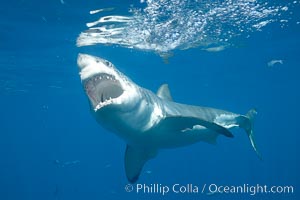
A great white shark opens it mouth just before it attacks its prey with a crippling, powerful bite. After the prey has been disabled, the shark will often wait for it to weaken from blood loss before resuming the attack. If the shark looses a tooth in the course of the bite, a replacement just behind it will move forward to take its place.
Species: Great white shark, Carcharodon carcharias
Location: Guadalupe Island (Isla Guadalupe), Baja California, Mexico
Image ID: 19452
Species: Great white shark, Carcharodon carcharias
Location: Guadalupe Island (Isla Guadalupe), Baja California, Mexico
Image ID: 19452
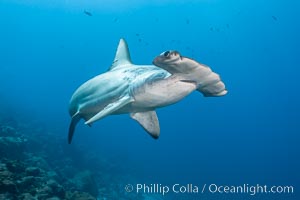
Scalloped hammerhead shark swims over a reef in the Galapagos Islands. The hammerheads eyes and other sensor organs are placed far apart on its wide head to give the shark greater ability to sense the location of prey.
Species: Scalloped hammerhead shark, Sphyrna lewini
Location: Wolf Island, Galapagos Islands, Ecuador
Image ID: 16246
Species: Scalloped hammerhead shark, Sphyrna lewini
Location: Wolf Island, Galapagos Islands, Ecuador
Image ID: 16246
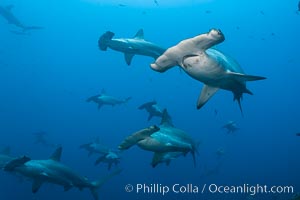
Hammerhead sharks swim in a school underwater at Wolf Island in the Galapagos archipelago. The hammerheads eyes and other sensor organs are placed far apart on its wide head to give the shark greater ability to sense the location of prey.
Species: Scalloped hammerhead shark, Sphyrna lewini
Location: Wolf Island, Galapagos Islands, Ecuador
Image ID: 16271
Species: Scalloped hammerhead shark, Sphyrna lewini
Location: Wolf Island, Galapagos Islands, Ecuador
Image ID: 16271
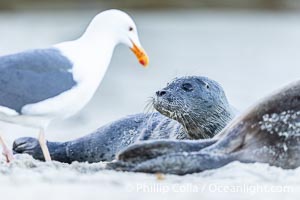
Newborn harbor seal pup watches a Western seagull approach. The gull is trying to pick at placenta on the sandy beach as the seal pup, born just moments before, watches and tries to understand what is going on. Within an hour of being born, this pup had learned to nurse and had entered the ocean for its first swim.
Species: Pacific harbor seal, Phoca vitulina richardsi
Location: La Jolla, California
Image ID: 39076
Species: Pacific harbor seal, Phoca vitulina richardsi
Location: La Jolla, California
Image ID: 39076
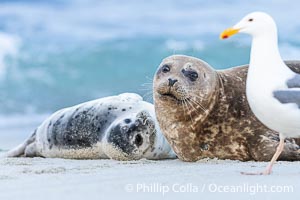
Harbor Seal Mother and Pup watch a Western Gull. The gull may be looking for placental material on the beach during pupping season.
Species: Pacific harbor seal, Phoca vitulina richardsi
Location: La Jolla, California
Image ID: 39066
Species: Pacific harbor seal, Phoca vitulina richardsi
Location: La Jolla, California
Image ID: 39066
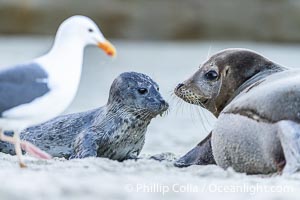
Newborn harbor seal pup is protected by its mother from a seagull. The seagull most likely wants to feed on the placenta, but it may also peck at and injure the pup. The seal mother does a good job of keeping birds off its newborn pup. Within an hour of being born, this pup had learned to nurse and had entered the ocean for its first swim.
Species: Pacific harbor seal, Phoca vitulina richardsi
Location: La Jolla, California
Image ID: 39075
Species: Pacific harbor seal, Phoca vitulina richardsi
Location: La Jolla, California
Image ID: 39075
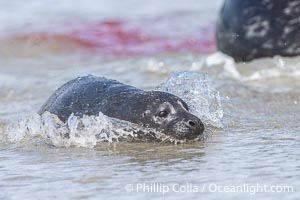
A newborn harbor seal pup in the water at the oceans edge, born just moments before in the ocean and immediately able to swim ashore. The pups placenta and mother are seen in the background.
Species: Pacific harbor seal, Phoca vitulina richardsi
Location: La Jolla, California
Image ID: 39101
Species: Pacific harbor seal, Phoca vitulina richardsi
Location: La Jolla, California
Image ID: 39101
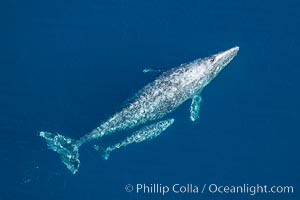
Aerial photo of gray whale calf and mother. This baby gray whale was born during the southern migration, far to the north of the Mexican lagoons of Baja California where most gray whale births take place.
Species: Gray whale, Eschrichtius robustus
Location: San Clemente, California
Image ID: 29017
Species: Gray whale, Eschrichtius robustus
Location: San Clemente, California
Image ID: 29017
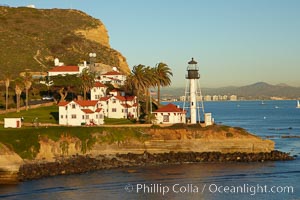
New Point Loma Lighthouse, situated on the tip of Point Loma Peninsula, marks the entrance to San Diego Bay. The lighthouse rises 70' and was built in 1891 to replace the "old" Point Loma Lighthouse which was often shrouded in fog.
Location: San Diego, California
Image ID: 22295
Location: San Diego, California
Image ID: 22295
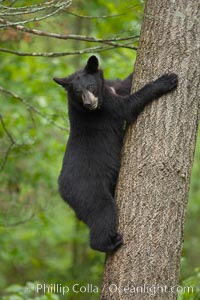
Black bear in a tree. Black bears are expert tree climbers and will ascend trees if they sense danger or the approach of larger bears, to seek a place to rest, or to get a view of their surroundings.
Species: American black bear, Ursus americanus
Location: Orr, Minnesota
Image ID: 18745
Species: American black bear, Ursus americanus
Location: Orr, Minnesota
Image ID: 18745
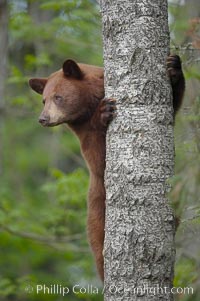
Black bear in a tree. Black bears are expert tree climbers and will ascend trees if they sense danger or the approach of larger bears, to seek a place to rest, or to get a view of their surroundings.
Species: American black bear, Ursus americanus
Location: Orr, Minnesota
Image ID: 18747
Species: American black bear, Ursus americanus
Location: Orr, Minnesota
Image ID: 18747
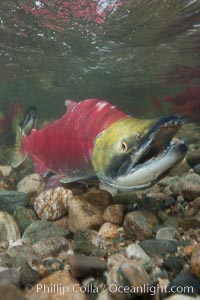
A male sockeye salmon, showing injuries sustained as it migrated hundreds of miles from the ocean up the Fraser River, swims upstream in the Adams River to reach the place where it will fertilize eggs laid by a female in the rocks. It will die so after spawning.
Species: Sockeye salmon, Oncorhynchus nerka
Location: Adams River, Roderick Haig-Brown Provincial Park, British Columbia, Canada
Image ID: 26147
Species: Sockeye salmon, Oncorhynchus nerka
Location: Adams River, Roderick Haig-Brown Provincial Park, British Columbia, Canada
Image ID: 26147
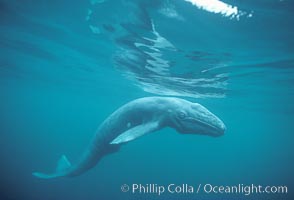
A neonate gray whale calf, born just hours before, still exhbiting embryonic folds in the skin along its side. This baby gray whale was born in the cold waters of Big Sur, far to the north of the Mexican lagoons of Baja California where most gray whale births take place.
Species: Gray whale, Eschrichtius robustus
Location: Monterey, California
Image ID: 01135
Species: Gray whale, Eschrichtius robustus
Location: Monterey, California
Image ID: 01135
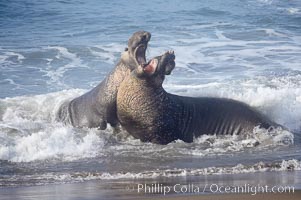
Male elephant seals (bulls) rear up on their foreflippers and fight in the surf for access for mating females that are in estrous. Such fighting among elephant seals can take place on the beach or in the water. They bite and tear at each other on the neck and shoulders, drawing blood and creating scars on the tough hides.
Species: Elephant seal, Mirounga angustirostris
Location: Piedras Blancas, San Simeon, California
Image ID: 20369
Species: Elephant seal, Mirounga angustirostris
Location: Piedras Blancas, San Simeon, California
Image ID: 20369
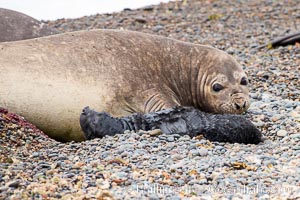
Southern elephant seal pup taking its first breath. Just moments before the pup was still wrapped in placenta and had to free its head in order to breathe, Mirounga leonina, Valdes Peninsula.
Species: Southern elephant seal, Mirounga leonina
Location: Puerto Piramides, Chubut, Argentina
Image ID: 38420
Species: Southern elephant seal, Mirounga leonina
Location: Puerto Piramides, Chubut, Argentina
Image ID: 38420
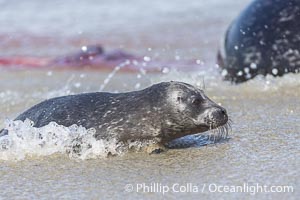
A newborn harbor seal pup in the water at the oceans edge, born just moments before in the ocean and immediately able to swim ashore. The pups placenta and mother are seen in the background.
Species: Pacific harbor seal, Phoca vitulina richardsi
Location: La Jolla, California
Image ID: 39100
Species: Pacific harbor seal, Phoca vitulina richardsi
Location: La Jolla, California
Image ID: 39100
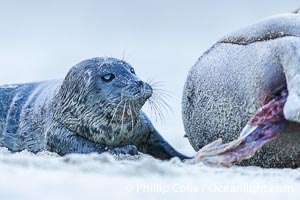
A newborn harbor seal pup rests alongside its mother, as placenta is born from the mother just a few moments after the pup was born. Within an hour of being born, this pup had learned to nurse and had entered the ocean for its first swim.
Species: Pacific harbor seal, Phoca vitulina richardsi
Location: La Jolla, California
Image ID: 39110
Species: Pacific harbor seal, Phoca vitulina richardsi
Location: La Jolla, California
Image ID: 39110
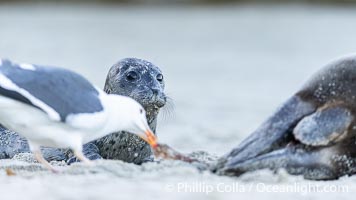
A Western seagull picks at placenta on sand beach, as the seal pup born just moments before watches and tries to understand what is going on. Within an hour of being born, this pup had learned to nurse and had entered the ocean for its first swim.
Species: Pacific harbor seal, Phoca vitulina richardsi
Location: La Jolla, California
Image ID: 39111
Species: Pacific harbor seal, Phoca vitulina richardsi
Location: La Jolla, California
Image ID: 39111
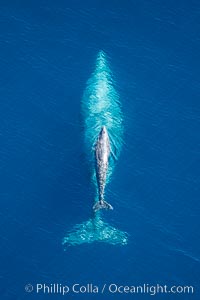
Aerial photo of gray whale calf and mother. This baby gray whale was born during the southern migration, far to the north of the Mexican lagoons of Baja California where most gray whale births take place.
Species: Gray whale, Eschrichtius robustus
Location: San Clemente, California
Image ID: 29001
Species: Gray whale, Eschrichtius robustus
Location: San Clemente, California
Image ID: 29001
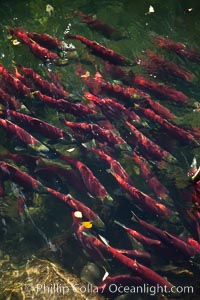
Sockeye salmon, swim upstream in the Adams River, traveling to reach the place where they hatched four years earlier in order to spawn a new generation of salmon eggs.
Species: Sockeye salmon, Oncorhynchus nerka
Location: Adams River, Roderick Haig-Brown Provincial Park, British Columbia, Canada
Image ID: 26165
Species: Sockeye salmon, Oncorhynchus nerka
Location: Adams River, Roderick Haig-Brown Provincial Park, British Columbia, Canada
Image ID: 26165
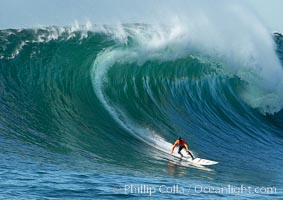
Brock Little, final round, Mavericks surf contest (third place), February 7, 2006.
Location: Mavericks, Half Moon Bay, California
Image ID: 15300
Location: Mavericks, Half Moon Bay, California
Image ID: 15300
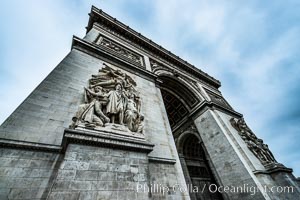
Arc de Triomphe. The Arc de Triomphe (Arc de Triomphe de l'Etoile) is one of the most famous monuments in Paris. It stands in the centre of the Place Charles de Gaulle (originally named Place de l'Etoile), at the western end of the Champs-Elysees. The Arc de Triomphe (in English: "Triumphal Arch") honors those who fought and died for France in the French Revolutionary and the Napoleonic Wars, with the names of all French victories and generals inscribed on its inner and outer surfaces. Beneath its vault lies the Tomb of the Unknown Soldier from World War I. The monument was designed by Jean Chalgrin in 1806, and its iconographic program pitted heroically nude French youths against bearded Germanic warriors in chain mail. It set the tone for public monuments, with triumphant patriotic messages. The monument stands 50 metres (164 ft) in height, 45 m (148 ft) wide and 22 m (72 ft) deep.
Location: Arc de Triomphe, Paris, France
Image ID: 28083
Location: Arc de Triomphe, Paris, France
Image ID: 28083
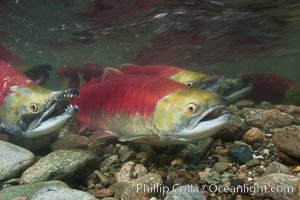
Sockeye salmon, swimming upstream in the shallow waters of the Adams River. When they reach the place where they hatched from eggs four years earlier, they will spawn and die.
Species: Sockeye salmon, Oncorhynchus nerka
Location: Adams River, Roderick Haig-Brown Provincial Park, British Columbia, Canada
Image ID: 26152
Species: Sockeye salmon, Oncorhynchus nerka
Location: Adams River, Roderick Haig-Brown Provincial Park, British Columbia, Canada
Image ID: 26152
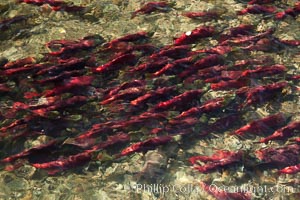
Sockeye salmon, swim upstream in the Adams River, traveling to reach the place where they hatched four years earlier in order to spawn a new generation of salmon eggs.
Species: Sockeye salmon, Oncorhynchus nerka
Location: Adams River, Roderick Haig-Brown Provincial Park, British Columbia, Canada
Image ID: 26155
Species: Sockeye salmon, Oncorhynchus nerka
Location: Adams River, Roderick Haig-Brown Provincial Park, British Columbia, Canada
Image ID: 26155
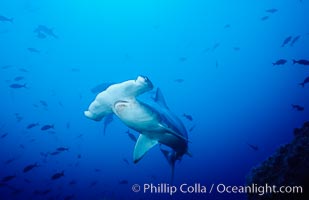
Scalloped hammerhead shark swims underwater at Cocos Island. The hammerheads eyes and other sensor organs are placed far apart on its wide head to give the shark greater ability to sense the location of prey.
Species: Scalloped hammerhead shark, Sphyrna lewini
Location: Cocos Island, Costa Rica
Image ID: 03192
Species: Scalloped hammerhead shark, Sphyrna lewini
Location: Cocos Island, Costa Rica
Image ID: 03192
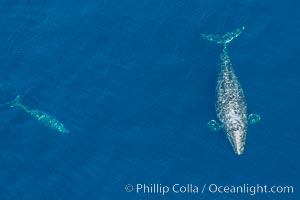
Aerial photo of gray whale calf and mother. This baby gray whale was born during the southern migration, far to the north of the Mexican lagoons of Baja California where most gray whale births take place.
Species: Gray whale, Eschrichtius robustus
Location: San Clemente, California
Image ID: 29031
Species: Gray whale, Eschrichtius robustus
Location: San Clemente, California
Image ID: 29031
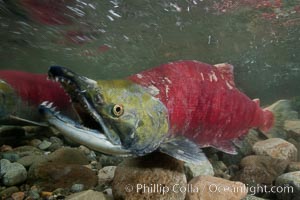
A male sockeye salmon, showing injuries sustained as it migrated hundreds of miles from the ocean up the Fraser River, swims upstream in the Adams River to reach the place where it will fertilize eggs laid by a female in the rocks. It will die so after spawning.
Species: Sockeye salmon, Oncorhynchus nerka
Location: Adams River, Roderick Haig-Brown Provincial Park, British Columbia, Canada
Image ID: 26151
Species: Sockeye salmon, Oncorhynchus nerka
Location: Adams River, Roderick Haig-Brown Provincial Park, British Columbia, Canada
Image ID: 26151
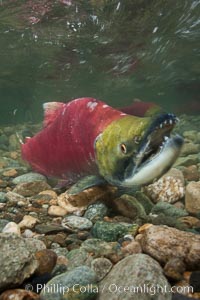
A male sockeye salmon, showing injuries sustained as it migrated hundreds of miles from the ocean up the Fraser River, swims upstream in the Adams River to reach the place where it will fertilize eggs laid by a female in the rocks. It will die so after spawning.
Species: Sockeye salmon, Oncorhynchus nerka
Location: Adams River, Roderick Haig-Brown Provincial Park, British Columbia, Canada
Image ID: 26166
Species: Sockeye salmon, Oncorhynchus nerka
Location: Adams River, Roderick Haig-Brown Provincial Park, British Columbia, Canada
Image ID: 26166
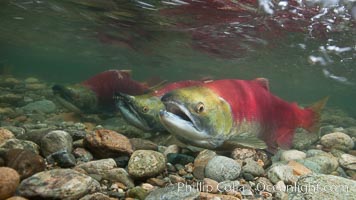
Sockeye salmon, swimming upstream in the shallow waters of the Adams River. When they reach the place where they hatched from eggs four years earlier, they will spawn and die.
Species: Sockeye salmon, Oncorhynchus nerka
Location: Adams River, Roderick Haig-Brown Provincial Park, British Columbia, Canada
Image ID: 26169
Species: Sockeye salmon, Oncorhynchus nerka
Location: Adams River, Roderick Haig-Brown Provincial Park, British Columbia, Canada
Image ID: 26169
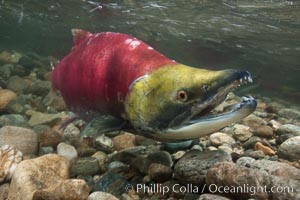
A male sockeye salmon, showing injuries sustained as it migrated hundreds of miles from the ocean up the Fraser River, swims upstream in the Adams River to reach the place where it will fertilize eggs laid by a female in the rocks. It will die so after spawning.
Species: Sockeye salmon, Oncorhynchus nerka
Location: Adams River, Roderick Haig-Brown Provincial Park, British Columbia, Canada
Image ID: 26171
Species: Sockeye salmon, Oncorhynchus nerka
Location: Adams River, Roderick Haig-Brown Provincial Park, British Columbia, Canada
Image ID: 26171